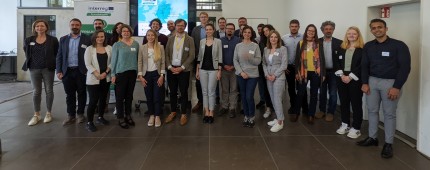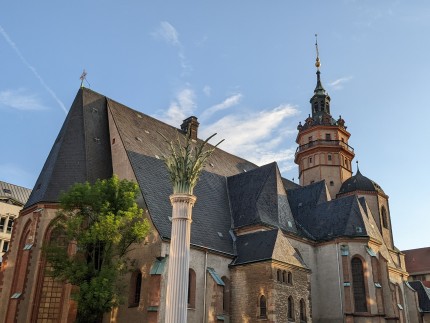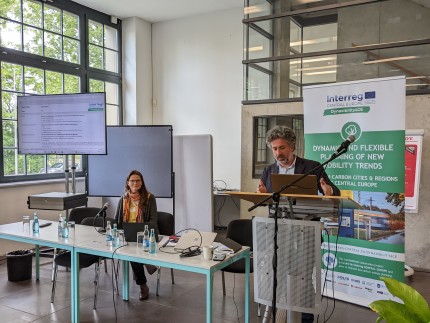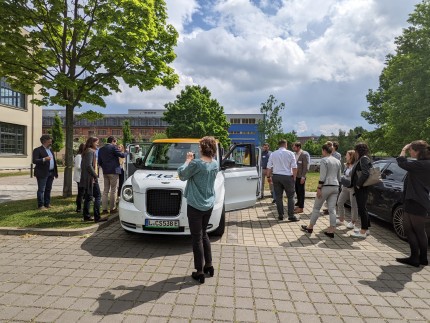Dynaxibility4CE Final Conference: an overview of mobility innovation in Central Europe
The final conference, one major milestone towards the finalisation of the Dynaxibility4CE project, took place on 17 May 2022 in Leipzig, Germany. Thanks to the excellent organisation from Leipziger Verkehrsbetriebe, around 30 project partners and external stakeholders had the chance to learn about the results of the cooperation between the Dynaxibility4CE project partners, which include seven cities and six organisations. Dedicated sessions on UVAR, MaaS and CCAM were followed by a presentation of a ‘Flexa’ vehicle that is used for the local demand responsive transport pilot in Leipzig. The one-day event concluded with two workshops on CCAM and MaaS. Furthermore, the project represents a great stepping stone for the participating cities on the long way towards the decarbonisation of urban mobility and their efforts to boost low-carbon transport solutions.

The host city of Leipzig has significantly transformed thanks to many national and international companies that have set up larger branches in the city. This resulted in an economic boom in the decades after the fall of the Iron Curtain, which attracted a significant number of high-skilled workers to Leipzig – an increase of inhabitants by more than 10% in the last 10 years.
In order to cope with these numbers, investments into public transport solutions were made and new projects were launched. An overview of these developments was given as an opening statement by Ronald Juhrs, Director of Leipziger Verkehrsbetriebe. The ‘ABSOLUT project’ that focuses on autonomous driving and the Flexa project that represent a demand-responsive transport solution, are two innovative examples. Juhrs emphasised that both flagship projects and the support of the Dynaxibility4CE project can be a significant cornerstone to future-proof urban mobility in Leipzig.

The event continued with three one-hour long blocks that covered the Dynaxibility4CE topics of UVAR, MaaS and CCAM. The UVAR session highlighted the importance of active communication and exchange with the residents that are directly impacted by the envisaged UVAR. The two cities of Krakow and Parma took a big step towards the implementation of an UVAR that also keeps the functional urban area (FUA) in consideration. This geographical area includes the municipalities at the outskirts of the city that are the home of most commuters. Therefore, this holistic approach avoids the displacement of traffic into neighbouring areas.
The three MaaS presentations of Graz, Budapest and Koprivnica were very interesting for the attendees, as the three Central European cities are representing different stages of progress towards the deployment of MaaS in their respective cities. Whereas the transport operator of Budapest, BKK, is already trying to integrate additional services into their existing mobility app, Graz is in the stakeholder consultation phase. The city administration of the Styrian capital has organised a large citizens’ survey with more than 150 submissions that will be used to create a MaaS mobility offer for a wide user base.

The third block that focused on CCAM had limited possibilities for exchange with the audience, as the City of Stuttgart was only represented through a video message due to a COVID-19 illness. Thanks to Dynaxibility4CE, Stuttgart had the chance to conduct a case study for the deployment of autonomous vehicles in the peri-urban Schurwald region in the East of the city centre. The study, which was presented during several European events throughout the course of the project, is considered as a great base to work on a potential pilot case. Regardless of any potential future plans, the Schurwald study is a great example to assess the potential of CCAM in Stuttgart. The overall conclusion of the study is the absolute necessity for an effective integration of CCAM with public transport in the Schurwald area.

In the afternoon, the two Leipzig-based pilots were presented. As previously mentioned, the ‘ABSOLUT project’ aims to test an autonomous shuttle on a frequented road of seven kilometers between a mobility hub and a local factory of the German car manufacturer BMW. Whereas several cities have tested slower autonomous shuttles and people movers, the project in Leipzig wants to take a significant leap forward by increasing the driving speed of the shuttle to 70km/h. This would test the road capability of such vehicle in an everyday use case. Once the testing will start this year, a driver needs to monitor the vehicle, but the project consortium is confident to build a secure vehicle so that the ‘driver’ becomes redundant. These steps not only depend on the quality of the vehicle, but also on the German legislative framework.
Furthermore, attendees had the opportunity to climb into a car of the ‘Flexa project’. The DRT service that was deployed in two dedicated areas in Leipzig as a pilot project allows users to be picked up at one of several hundred ‘virtual stops’ in the area. The spacious vehicle that allows great accessibility for people with disabilities brings the users to the next mobility hub, which allows them to continue their trip via public transport.
Overall, the day was used for fruitful exchanges and for the dissemination of project results. Further information will follow with the publication of three topic guides and the final brochure.
